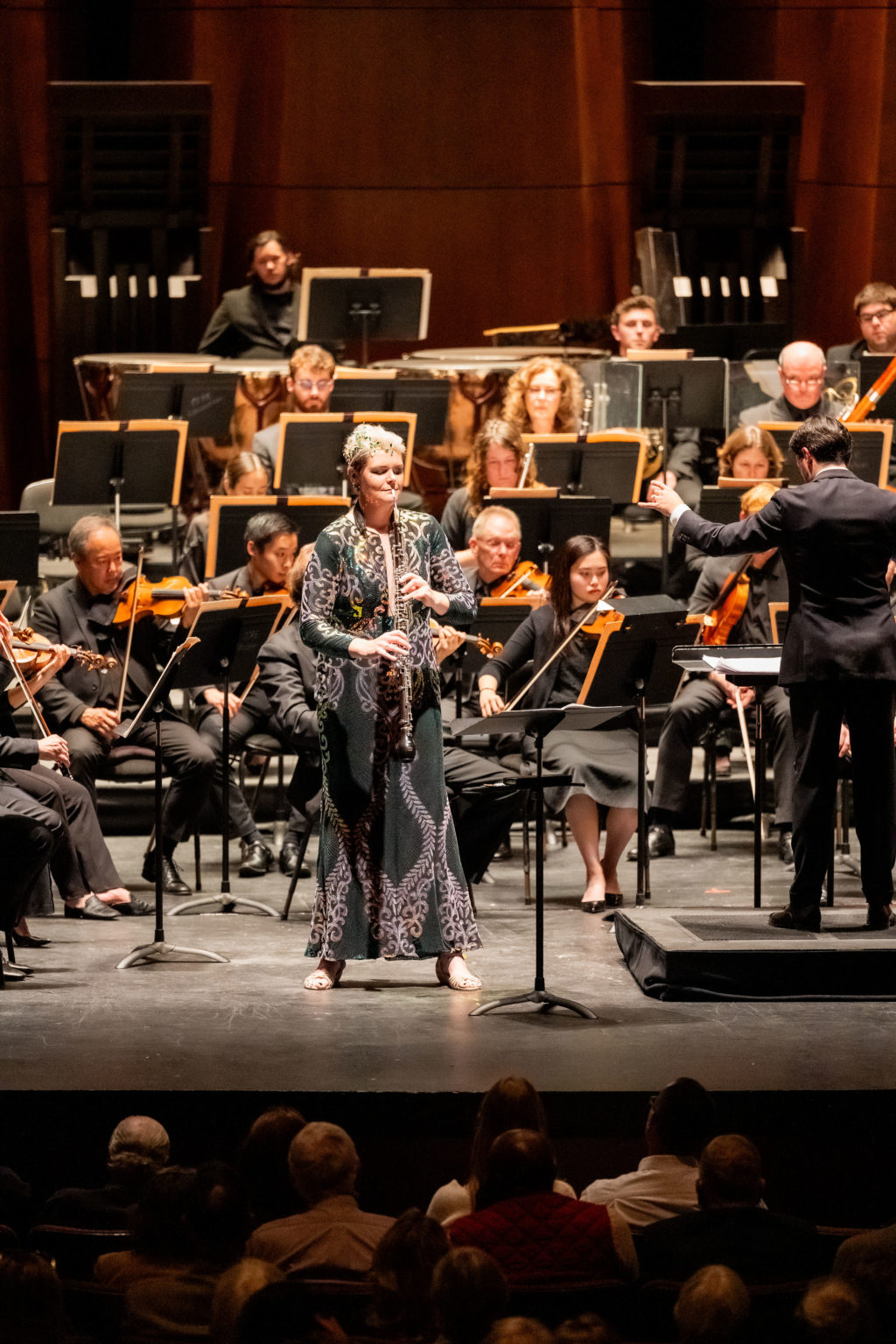San Diego Symphony Contrasts the Rare Ned Rorem English Horn Concerto with Mussorgsky’s Evergreen ‘Pictures at an Exhibition’ in Escondido Concert
On Saturday, even before I arrived at the California Center for the Arts In Escondido to hear the San Diego Symphony, two aspects of the program had intrigued me. The program featured Ned Rorem’s Concerto for English Horn and Orchestra, a work I had never previously known about much less heard, and the young Spanish guest conductor Antonio Méndez, who was making his San Diego debut on the podium.
Rorem’s 1992 Concerto for English Horn and Orchestra is clearly not the sort of pyrotechnical showpiece—like the Rachmaninoff piano concertos or Samuel Barber’s Violin Concerto—that many concertgoers have come to expect. In every movement of the Rorem concerto, the composer has taken advantage of the English horn’s greatest virtue: to spin out long, luxurious, supple melodies. Rorem’s concerto is more like a grand tone poem for English horn and orchestra in which the composer has provided deft and highly varied accompaniments from different sections of the orchestra to complement but never overpower the English horn.
Andrea Overturf, longstanding occupant of the orchestra’s endowed English horn chair, gave a compelling account of the concerto’s solo role. From her mellow incantation of the coy opening motifs of the concerto’s first movement, “Preamble and Amble,” to its jaunty, assertive themes that she then confidently tossed back and forth with the brass sections, Overturf relished the center stage spotlight and invited the listeners to also savor her ebullient spirit.Rorem structured his concerto in a five movement arch form, a favorite device of Béla Bartók. In the second movement, “Love Letter,” Overturf offered its long, sinuous themes with appropriate ardor and finesse, gently supported by the warmth of the cello and contrabass sections. The center movement, “Recurring Dream,” started as a dreamy aria for solo oboe but quickly expanded into a moving duet of intense yearning with Principal Cello Yao Zhao, which struck me as the heart of this concerto. Welcome contrast arrived with the fourth movement as Overturf unleashed a barrage of precisely executed busy, excited motor rhythms over pizzicato strings to fulfill the movement’s title, “Perpetual Motion.” A rhapsody that encompassed both mystery and nostalgia, the finale “Medley and Prayer” gave the soloist more opportunities to pair with other wind soloists in the orchestra offering comfort and consolation as their closing benediction.
Guest conductor Antonio Méndez proved a winning, gracious collaborator with Overturf in this concerto, shaping the orchestra with her at every turn while maintaining a judicious dynamic balance between these two very unequal forces. I hope Music Director Rafael Payare does not allow this score simply to gather dust on the library shelf; it would make a fine contribution to a program on a balmy summer evening at The Rady Shell.Modest Mussorgsky’s Pictures at an Exhibition in the Maurice Ravel orchestration has proven a favorite showpiece for Rafael Payare, who has conducted the orchestra in this work in 2019 and 2022. Antonio Méndez’s immaculately detailed yet emotionally rich account of this familiar work, however, made it feel uncannily fresh–even scintillating. From the first iteration of the “Promenade” theme, Principal Trumpet Christopher Smith and the brass sections announced this noble motif with a sumptuous yet cleanly focused sonority they maintained throughout its several appearances in the work.
Méndez cultivated the haunting mystery of “The Old Castle,” coaxing alluring solos from various first-chair players as well as guest saxophone Mark Shannon. Principal Tuba Aaron McCalla’s mellow solo cannily depicted an ox-cart trundling through muddy byways in “Bydlo,” and I admired the transparent sheen of nattering woodwinds an deft violin pizzicatos that portray the “Ballet of the Chicks in Their Shells.” Christopher Smith commanded the volley of demanding, sustained staccato trumpet iterations that hovers over the rumble of low strings in “Samuel Goldenberg and Schmuyle,” followed by the visceral excitement of “Limoges,” where Méndez tested the mettle of the string sections with his demanding tempo. Mussorgsky contrasts the awe of a trip through the gloomy “Catacombs” with a bristling caricature of the legendary witch Baba Yaga in “The Hut on Fowl’s Legs,” a scene vividly realized by the full orchestra. Nothing compares with the grandeur Mussorgsky creates in “The Great Gates of Kiev,” and Méndez and the orchestra fulfilled my highest expectations with thundering majesty and a heroic pulse that suspended time. It is ironic to appreciate this 19th-century Russian composer’s tribute to the city of Kiev in a time when the current Russian “czar” is attempting to bomb the city of Kiev out of existence.
Robert Schumann’s Overture, Scherzo, and Finale, Op. 52, is rarely heard for good reason, although Méndez presented it with ample confidence and flair. Apparently Schumann had hoped these movements would turn into a symphony, but he wisely filed it away and started fresh for what would become his Second Symphony. Op. 52 is a collection of modest ideas that resist development, which is the first requirement for any symphony written after Beethoven.
This concert was presented by the San Diego Symphony at the California Center for the Arts in Escondido, CA, on Saturday, March 9, 2024.

Ken Herman, a classically trained pianist and organist, has covered music for the San Diego Union, the Los Angeles Times’ San Diego Edition, and for sandiego.com. He has won numerous awards, including first place for Live Performance and Opera Reviews in the 2017, the 2018, and the 2019 Excellence in Journalism Awards competition held by the San Diego Press Club. A Chicago native, he came to San Diego to pursue a graduate degree and stayed.Read more…



Ken, this truly was a wonderful evening of spectacular music with sensitive fine conducting. Thank you for your compelling and gracious review of this concert.